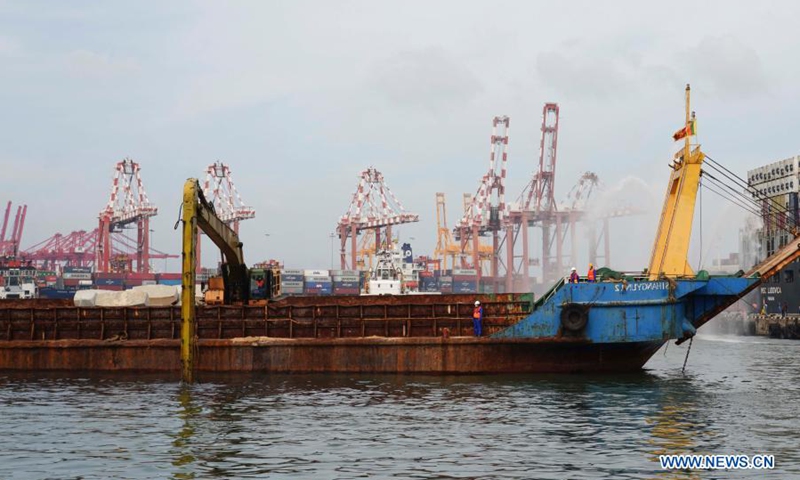Chinese container makers work at full capacity amid global supply shortage
By Yin Yeping Source: Global Times Published: 2020/12/23 22:19:20
Shortage persists due to rising cost, delivery delays

An engineering boat of the China Harbor Engineering Company (CHEC) stands by at the Jaya Container Terminal (JCT) at the Port of Colombo, Colombo, Sri Lanka, Dec. 1, 2020, getting ready for the JCT expansion project. CHEC has begun construction for the expansion of the Jaya Container Terminal (JCT) in the Port of Colombo in Sri Lanka. Expansion of the fifth phase of the JCT was initiated on Tuesday.(Photo: Xinhua)
With jammed ports, halted production and disrupted logistics continuing to paralyze the US, Australia and some European countries amid the pandemic, Chinese container makers have been working at full capacity since mid-year -- but they still can't meet demand, while costs soar and delivery times for some raw materials get longer.
Industry insiders said container shortages will persist at least until the second quarter of 2021, and may worsen, depending on the course of the pandemic in the nation's trading partners, including the US and the EU.
A marketing manager surnamed Zhang with container maker Singamas told the Global Times on Wednesday that the container shortage really began to get serious in the third quarter due to the pandemic. But tight supplies of raw materials mean that it's hard to expand output.
"The recent spike in iron ore prices has led to high steel prices, and seasonal supplies of bamboo and wood for container floors are tight in autumn and winter. These factors only make the situation worse and push up our costs," said Zhang. In addition, it may take longer for raw materials to be delivered.
China's container production and sales account for 96 percent of the global market, with a full product line, supply chain, and the technical capacity of an industry cluster, the China Container Industry Association (CCIA) said.
To reduce market uncertainty in the upstream, the body pre-ordered some raw materials, but the goods can't be delivered until March or April. The delivery time used to be just three weeks.
Zhang said that current orders for containers have been delayed until the second quarter of next year.
CXIC Group Containers, based in East China's Jiangsu Province, has a 13-percent market share. It has warned that the container shortage will last beyond the Spring Festival.
The company has five production lines, with an annual capacity of 900,000 TEUs, and 90 percent of its output is exported to more than 40 countries and regions. The only way to expand output is to work overtime, so the company can't take new orders, a manager surnamed Zhen told the Global Times on Wednesday.
The price of iron ore in Australia has soared recently to 1,040 yuan ($159) per ton. As Chinese steelmakers are the buyers, rising prices mean higher steel prices for container producers, said industry insiders.
The headaches of container makers are affecting freight suppliers who are facing unevent distribution of containers around the world due to trade surplus.
Meanwhile, ports in the US, Europe and Australia are full of empty containers with nowhere to go.
In the face of uncertainty, a manager surnamed Mao with Zhonghuan Group, an international freight service provider in Dalian, Northeast China's Liaoning Province, said that new containers are too expensive to buy now. Even "a secondhand container usually costs 5,000-6,000 yuan, but now it costs 17,000 yuan," said Mao.
Container factories are working at full capacity with longer hours, the CCIA said.
In response to the container sector's hurdles, Chinese authorities have vowed to tackle the issue.
Policies will be formulated to tackle problems such as soaring freight rates, container shortages and exchange rate appreciation, Zhang Li, deputy director general of the foreign trade department of the Ministry of Commerce, said on Wednesday at the China Electronics and Household Appliances Global Business Forum.
Newspaper headline: Container firms at full capacity